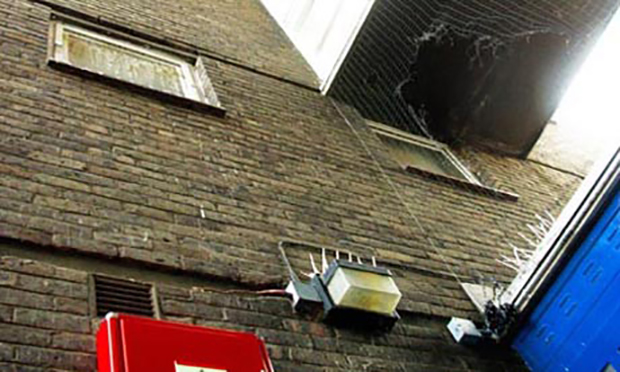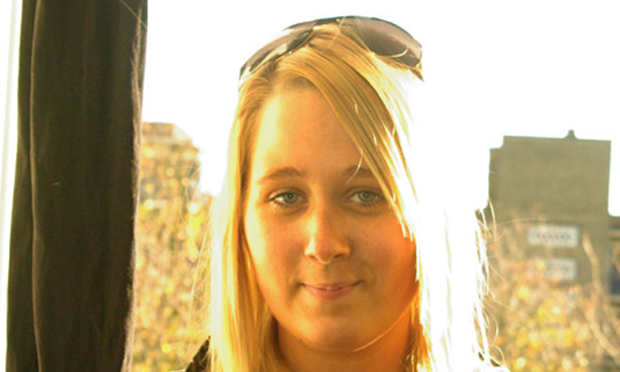‘It’s like prison’ – tenants tell of tower block fire fears

Frampton Park Estate tower block
Hackney residents living in tower blocks at high risk from fire have described dangerous conditions and their fear that officials are putting value for money before their safety.
Three blocks on the Frampton Park Estate (E9) were found to be at “high risk” from fire when they were inspected in August after a devastating blaze at a medium risk-rated block in Camberwell claimed six lives a month earlier.
It took housing inspectors two years to visit Barbrook House, Exbury House and Scotney House on the Frampton Park Estate and classify them as being at high risk – an assessment made after hazards such as problem escape routes, emergency lighting, the presence of flammable materials and ventilation are checked.
Hackney Homes, which manages the Frampton Park council blocks, told the Citizen that since 2007, “every block in the borough over six storeys has received a fire risk assessment”.
The arms-length management organisation said its staff had visited the three high risk blocks and that work to make them safe would be completed by the end of the year.
But one local resident said fire exits in Scotney House had been blocked off. Lee David Payne said he did not think he would be able to escape from a fire. He said, “I live on the top floor and they blocked off the fire exits about two or three years back.”
Mr Payne said that although inspectors had visited some flats in the block, his had not yet been assessed. He described the two-year wait as unreasonable and dangerous.
Hackney housing officials have also defended their decision to install thousands of uPVC windows amid reports that the material may have contributed to the speed at which flames spread during the Lakanal House fire in Camberwell.
A Southwark Council spokesman has denied that the windows in Lakanal House are uPVC. But an architect who worked on the twelve-storey Southwark block said of the fire that plastic windows “were the problem”.
Bill Solman told the BBC, “Timber has limitations, but it’s better than plastic which melts. Plastic gives off cyanide fumes and burns fiercely.” He said that the windows in Lakanal House were “the main cause of the surface flame spread”.
The investigation into how the Camberwell fire spread has not yet been completed.
In a statement, Hackney Homes said the decision to use uPVC instead of wood for over 11,000 windows was made “on a value for money basis”. Hackney Homes “has explored other options including wood, however the lifespan of these products is half that of uPVC while the cost is double”, the statement said.

Exbury House resident Melissa Wingrove
But Exbury House resident Melissa Wingrove, 19, said, “It shouldn’t be about money. It should be more about our safety. We don’t feel safe at all in there. As soon as you walk in it’s like a prison.”
Miss Wingrove said housing inspectors had visited her property recently and promised residents new fire doors. But she said, “Nothing’s been done. We haven’t heard anything so far.”
Whilst Hackney Homes and the majority of local authorities do use uPVC windows in council homes, Camden does not.
Camden Council told the Citizen it uses sustainably sourced timber and thermal break metal products taking into account “both environmental and value for money considerations”.
Homes for Islington, which manages council blocks in that borough, told the Citizen they use a combination of aluminium, timber and uPVC windows depending on “individual circumstance and planning requirements” and after consultation with residents.
In the wake of the Lakanal House fire in Camberwell, the head of London’s fire brigade is working with local authorities to “improve awareness of the regulatory regime in place for fire safety” and has written to all local authorities, housing managers and landlords to “remind them of their responsibilities and to highlight the importance of fire safety”.
Fire commissioner Ron Dobson told a recent London Assembly meeting at City Hall that the Fire Brigade was keen to learn why the tower block fire in July spread so quickly.
“Tragically, six people died in this fire and like every serious incident, all aspects are being thoroughly investigated. We are keen to understand why the fire spread in the way that it did and learn any other lessons from the events of that tragic day,” the Fire commissioner said.
The Fire Brigade’s Union has previously expressed concern about the safety of uPVC building materials due to both the toxicity of the smoke produced and the destructive effects of hydrochloric acid on building structure in the event of a fire.
According to Hackney Homes, all 258 fire risk assessments for tower blocks of six storeys and above have now been completed and six blocks have been identified as ‘high risk’. They say that hazards have been removed from three of these blocks and risks “minimised”.
In a statement, Hackney Homes said they have made it a priority to carry out major works and to address any hazards in the three other blocks classified as high risk (Barbrook House; Scotney House and Exbury House).
Housing managers say the works will “provide secondary fire escape routes out of each flat in these blocks” and that, in the meantime, “all residents are able to use the main staircase as an escape route in the event of a fire”.
A Hackney Council spokesman said: “We take the safety of our residents extremely seriously. This is now being monitored at the highest level and Hackney Homes has provided the Council with a table showing dates when fire risk assessments were completed.”
